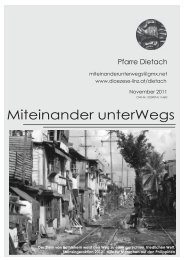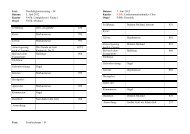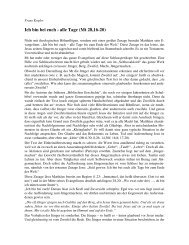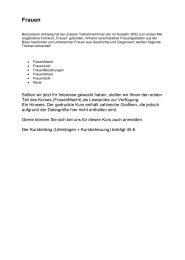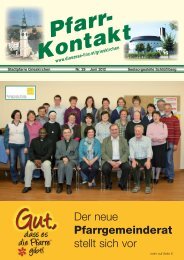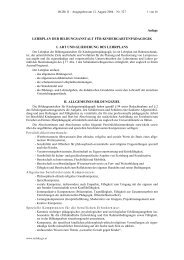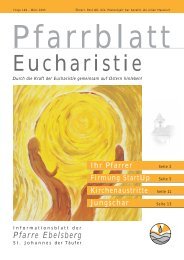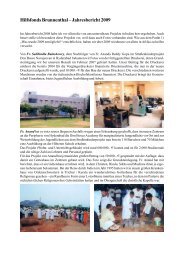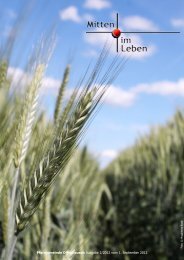The State of Food and Agriculture - FAO
The State of Food and Agriculture - FAO
The State of Food and Agriculture - FAO
Create successful ePaper yourself
Turn your PDF publications into a flip-book with our unique Google optimized e-Paper software.
42<br />
THE STATE OF FOOD AND AGRICULTURE 2006<br />
BOX 10<br />
<strong>Food</strong>-for-work <strong>and</strong> local agricultural production<br />
Anecdotal evidence suggests that food<br />
aid, in the form <strong>of</strong> FFW programmes, may<br />
harm local production by encouraging<br />
households to reallocate their labour<br />
away from production towards FFW. <strong>The</strong><br />
econometric or ethnographic evidence in<br />
support <strong>of</strong> this claim is thin, however, <strong>and</strong><br />
there are examples where the opposite<br />
seems to occur. In the case <strong>of</strong> FFW for<br />
on-farm soil <strong>and</strong> water conservation<br />
in Tigray, northern Ethiopia, on-farm<br />
labour <strong>and</strong> private investments increased<br />
(Holden, Barrett <strong>and</strong> Hagos, 2006). This<br />
also happened in the case <strong>of</strong> lean season<br />
FFW projects enabling smallholders to<br />
purchase fertilizer <strong>and</strong> hire labour to<br />
increase on-farm labour effort on their<br />
own plots in Baringo District <strong>of</strong> central<br />
Kenya (Bezuneh, Deaton <strong>and</strong> Norton,<br />
1988).<br />
FFW programmes are <strong>of</strong>ten used<br />
to counter a perceived “dependency<br />
syndrome” associated with freely<br />
distributed food. Yet, evidence suggests<br />
that poorly designed FFW programmes<br />
may risk harming local production more<br />
than free food distribution. Ravallion<br />
(1991) argued that setting wages correctly<br />
will induce self-targeting <strong>of</strong> food-insecure<br />
<strong>The</strong> welfare impacts <strong>of</strong> any changes in<br />
food prices induced by food aid are likely to<br />
be mixed. This can be most easily understood<br />
by thinking about the people in an area<br />
that receives food aid in terms <strong>of</strong> two<br />
criteria: whether or not they receive food<br />
aid (recipients versus non-recipients) <strong>and</strong><br />
whether they are net sellers or net buyers <strong>of</strong><br />
food. Figure 9 depicts the simple two-by-two<br />
matrix that results.<br />
In Figure 9, food aid in kind brings<br />
commodities into an area <strong>and</strong> drives down<br />
local prices. This unambiguously benefits food<br />
aid recipients <strong>and</strong> net food buyers through<br />
the direct transfer effect recipients enjoy, as<br />
well as through the indirect benefit that arises<br />
due to lower prices for the foods they buy.<br />
Even non-recipients benefit as long as they<br />
are net food buyers, because they can afford<br />
to buy more food when prices are lower.<br />
households whose time is less valuable<br />
than that <strong>of</strong> richer households. Barrett<br />
<strong>and</strong> Clay (2003) argue, however, that<br />
in structurally weak economies FFW<br />
programme design is not as simple as<br />
determining the appropriate wage rate.<br />
<strong>The</strong>y find that in rural Ethiopia, higherincome<br />
households had excess labour <strong>and</strong><br />
thus lower (not higher) value <strong>of</strong> time;<br />
therefore, these households allocated this<br />
labour to FFW schemes, in which poorer<br />
households could not afford to participate<br />
due to labour scarcity.<br />
Bennett (2001) argues that FFW<br />
programmes in Cambodia are an<br />
additional, not alternative, source <strong>of</strong><br />
employment <strong>and</strong> that the very poor rarely<br />
participate owing to labour constraints.<br />
<strong>The</strong>refore, some targeting in addition<br />
to FFW may be necessary to reach<br />
the neediest households. Identifying<br />
who should be eligible for FFW, ownproduction<br />
labour requirements, expected<br />
duration <strong>of</strong> the distribution, structural<br />
factors (such as productive assets available<br />
to a household) <strong>and</strong> local wages can<br />
help determine the appropriateness <strong>of</strong><br />
FFW <strong>and</strong> the risks <strong>of</strong> causing negative<br />
dependency.<br />
Net sellers <strong>of</strong> food are unambiguously<br />
worse <strong>of</strong>f because the price they receive<br />
for their output is lower. This negative<br />
effect could be <strong>of</strong>fset, however, if they<br />
also receive food aid or some other form<br />
<strong>of</strong> compensatory transfer. <strong>The</strong> welfare<br />
effects on net sellers who also receive aid<br />
are ambiguous, depending on how the<br />
unintended, adverse price effects balance<br />
out against the intended, positive transfer<br />
effects. This simple diagram captures the<br />
longst<strong>and</strong>ing concern about unintended<br />
adverse effects on net seller farmers as well<br />
as the intended benefits to net food buyers,<br />
who represent the majority <strong>of</strong> the poorest in<br />
virtually all communities.<br />
Figure 9 also shows the welfare effects<br />
<strong>of</strong> local <strong>and</strong> regional purchase operations,<br />
i.e. food aid interventions in local markets.<br />
When the food is purchased in the local




